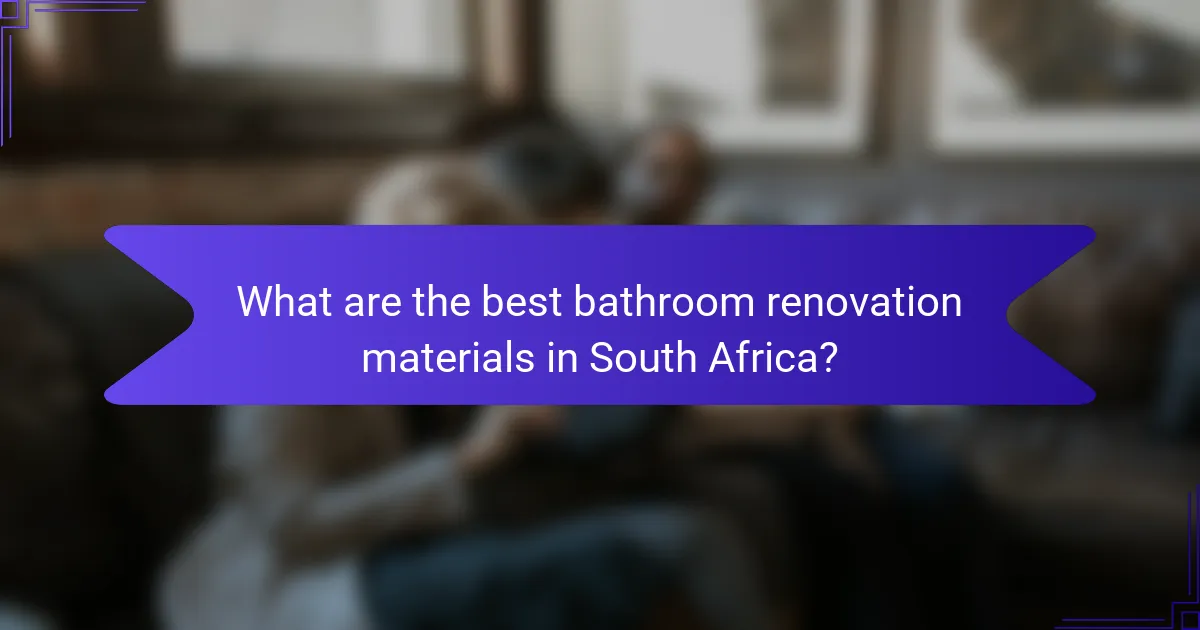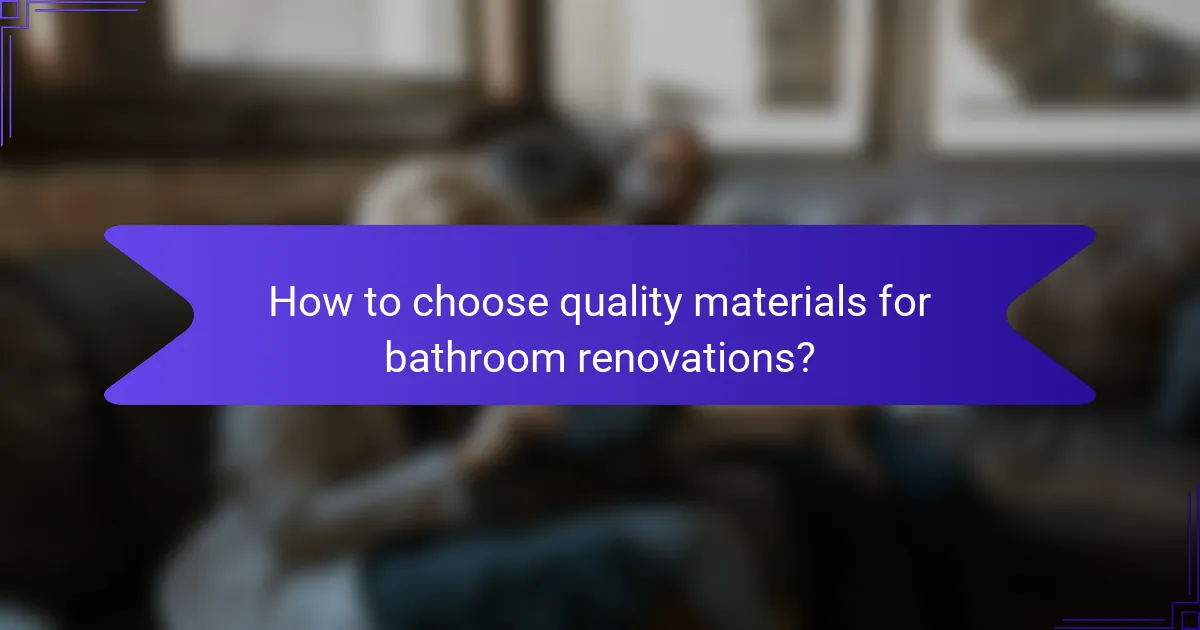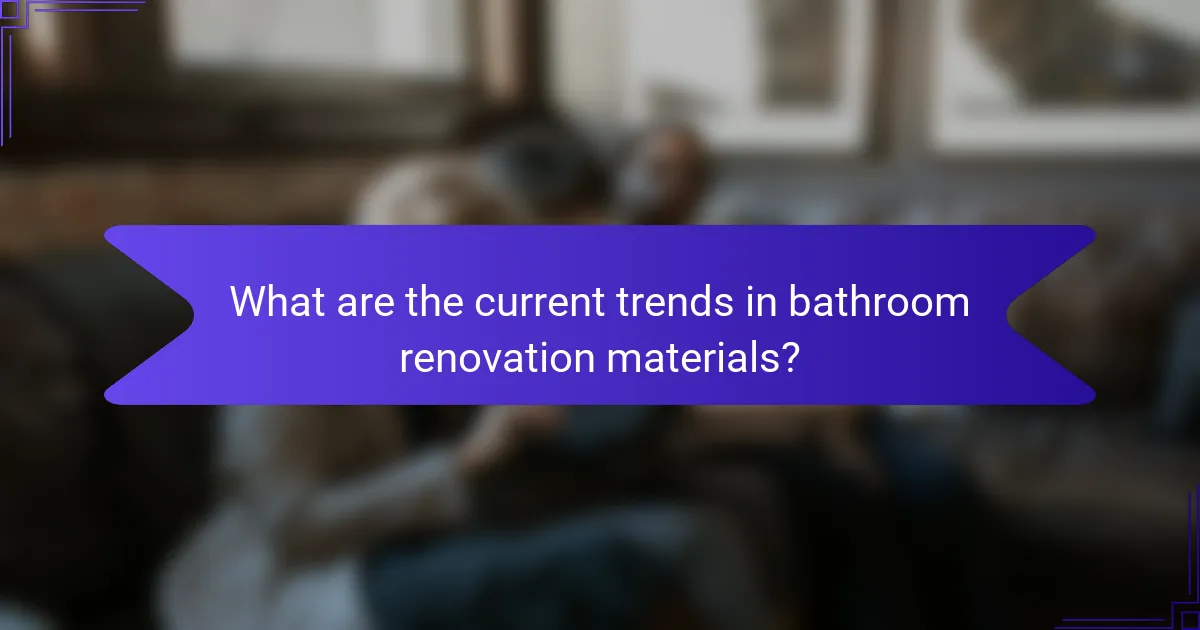When renovating a bathroom, selecting the right materials is crucial for achieving both durability and aesthetic appeal. Popular choices like porcelain tiles, quartz countertops, and water-resistant paint not only withstand the humid environment but also elevate the overall design. As trends shift towards sustainability and smart technology, homeowners are encouraged to consider eco-friendly options and bold designs that reflect their personal style.

What are the best bathroom renovation materials in South Africa?
The best bathroom renovation materials in South Africa include porcelain tiles, quartz countertops, water-resistant paint, vinyl flooring, and glass shower enclosures. These materials are favored for their durability, aesthetic appeal, and suitability for the humid environment typical in bathrooms.
Porcelain tiles
Porcelain tiles are a top choice for bathroom flooring and walls due to their water resistance and durability. They come in various styles and finishes, allowing for versatile design options that can mimic natural stone or wood.
When selecting porcelain tiles, consider the slip resistance rating, especially for flooring, to ensure safety. Prices typically range from R200 to R600 per square meter, depending on the quality and design.
Quartz countertops
Quartz countertops are engineered stone surfaces that offer a non-porous, durable option for bathroom vanities. They resist stains and scratches, making them ideal for high-use areas.
In South Africa, quartz countertops are available in a variety of colors and patterns, allowing homeowners to achieve a customized look. Expect to pay between R1,500 and R3,500 per square meter, which reflects their premium quality.
Water-resistant paint
Water-resistant paint is essential for bathroom walls to prevent mold and mildew growth. Look for paints labeled as moisture-resistant or specifically designed for bathrooms.
Brands often offer a range of colors and finishes, including matte and satin. A good quality water-resistant paint can cost between R300 and R600 per liter, providing a protective layer that enhances the room’s overall look.
Vinyl flooring
Vinyl flooring is a cost-effective and versatile option for bathroom renovations. It is available in sheets, tiles, or planks, and offers excellent water resistance and comfort underfoot.
When choosing vinyl, consider options with a textured surface for added slip resistance. Prices generally range from R150 to R400 per square meter, making it an attractive choice for budget-conscious renovations.
Glass shower enclosures
Glass shower enclosures add a modern touch to bathrooms while maximizing space and light. They can be framed or frameless, with various styles available to suit different design preferences.
When selecting a glass enclosure, ensure it is made from tempered glass for safety and durability. Costs can vary widely, typically ranging from R5,000 to R15,000, depending on size and design complexity.

How to choose quality materials for bathroom renovations?
Choosing quality materials for bathroom renovations involves evaluating durability, maintenance needs, water resistance, and warranty options. Prioritizing these factors ensures that your investment lasts and meets your functional and aesthetic requirements.
Evaluate durability
Durability is crucial in bathroom materials due to high humidity and frequent use. Look for materials that can withstand wear and tear, such as porcelain tiles, solid wood cabinetry, and quartz countertops. These options typically last longer and resist chipping or cracking better than cheaper alternatives.
Consider the lifespan of different materials. For instance, high-quality ceramic tiles can last several decades, while laminate surfaces may need replacement within 10 to 15 years. Investing in durable materials can save you money on future renovations.
Consider maintenance
Maintenance requirements vary significantly among bathroom materials. Some surfaces, like natural stone, may require regular sealing to prevent stains, while others, like vinyl flooring, are easier to clean and maintain. Assess how much time and effort you are willing to invest in upkeep.
For a low-maintenance option, consider materials that are resistant to mold and mildew, such as fiberglass shower surrounds or acrylic bathtubs. These choices can simplify cleaning and enhance the longevity of your bathroom.
Assess water resistance
Water resistance is a key factor in bathroom materials, as moisture can lead to mold, mildew, and structural damage. Look for materials specifically designed for wet environments, such as water-resistant drywall, ceramic tiles, and marine-grade plywood.
When selecting flooring, consider options like vinyl or porcelain tiles that offer excellent water resistance. Ensure that any grout used is also water-resistant to prevent moisture penetration and damage over time.
Check for warranties
Warranties can provide peace of mind when investing in bathroom materials. Check the manufacturer’s warranty to understand what is covered and for how long. High-quality materials often come with longer warranties, indicating confidence in their durability and performance.
Be cautious of materials with limited or no warranty, as this may signal lower quality. A good warranty can protect you against defects and ensure that you receive support if issues arise after installation.

What are the current trends in bathroom renovation materials?
Current trends in bathroom renovation materials focus on sustainability, aesthetics, and technology. Homeowners are increasingly opting for eco-friendly options, textured surfaces, bold colors, and smart technology to enhance functionality and style.
Eco-friendly materials
Eco-friendly materials are gaining popularity as homeowners prioritize sustainability in their renovations. Options like bamboo, recycled glass, and low-VOC (volatile organic compounds) paints minimize environmental impact while providing stylish finishes.
When selecting eco-friendly materials, consider certifications such as FSC (Forest Stewardship Council) for wood products or Energy Star for appliances. These certifications ensure that materials meet specific environmental standards, helping you make informed choices.
Textured surfaces
Textured surfaces add depth and interest to bathroom designs, moving away from flat finishes. Materials like textured tiles, stone, and even wood can create a tactile experience that enhances the overall aesthetic.
Incorporating textures can be done through accent walls, flooring, or even fixtures. For instance, a textured backsplash can serve as a focal point, while textured flooring can provide slip resistance, improving safety.
Bold colors
Bold colors are making a comeback in bathroom renovations, allowing homeowners to express their personality. Deep blues, vibrant greens, and rich reds can transform a bathroom from a simple space into a striking retreat.
When using bold colors, balance is key. Consider pairing a bold hue with neutral elements to avoid overwhelming the space. Accent pieces like towels or decor can also be used to introduce color without committing to a full renovation.
Smart technology integration
Smart technology integration is revolutionizing bathroom design, offering convenience and efficiency. Features like smart showers, automated lighting, and heated floors enhance comfort and energy savings.
When incorporating smart technology, prioritize compatibility with existing systems and ease of use. Look for user-friendly interfaces and reliable brands to ensure a seamless experience. Additionally, consider the long-term benefits of energy-efficient products, which can lead to savings on utility bills.

What are the costs associated with bathroom renovation materials?
The costs associated with bathroom renovation materials can vary widely based on quality, brand, and type. Homeowners should budget for tiles, fixtures, fittings, and labor, as these elements significantly impact the overall project cost.
Average pricing for tiles
Tile prices can range from budget-friendly options at around $5 to $15 per square foot to high-end selections that may exceed $30 per square foot. Factors influencing tile costs include material type, size, and design complexity.
Common tile materials include ceramic, porcelain, and natural stone, each with different price points. For example, ceramic tiles are generally more affordable, while natural stone tiles, like marble, can be significantly more expensive.
Cost of fixtures and fittings
Fixtures and fittings, such as sinks, faucets, and toilets, typically range from $100 to $1,000 or more, depending on the brand and style. Standard models are often more cost-effective, while designer options can drive prices higher.
When selecting fixtures, consider both functionality and aesthetics. Investing in quality fittings can enhance durability and reduce the need for future replacements, which can save money in the long run.
Budgeting for labor
Labor costs for bathroom renovations can vary based on location and the complexity of the project, generally ranging from $50 to $150 per hour. It’s essential to factor in these costs when estimating the total renovation budget.
Hiring a licensed contractor can ensure quality work, but be sure to obtain multiple quotes to compare pricing. Additionally, consider the potential for unexpected expenses, such as plumbing or electrical work, which may arise during the renovation process.

What factors influence the selection of bathroom materials?
The selection of bathroom materials is influenced by factors such as durability, moisture resistance, style preferences, and budget. Understanding these elements helps homeowners make informed choices that align with their renovation goals.
Style preferences
Style preferences play a crucial role in selecting bathroom materials, as they dictate the overall aesthetic and ambiance of the space. Homeowners should consider whether they prefer a modern, traditional, or eclectic look, as this will guide their material choices.
For example, sleek tiles and glass fixtures may suit a contemporary design, while natural stone and vintage-style fittings might enhance a classic atmosphere. It’s essential to create a cohesive look by ensuring that all materials complement each other.
When selecting materials, consider the color palette and textures that resonate with your style. Neutral tones can provide a timeless backdrop, while bold colors can make a statement. Aim for a balance that reflects personal taste while remaining functional and practical for a bathroom setting.
